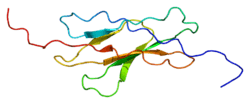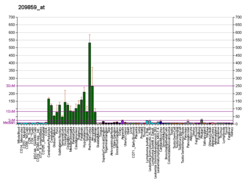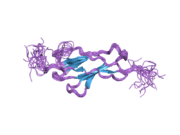TRIM9
Tripartite motif-containing protein 9 is a protein that in humans is encoded by the TRIM9 gene.[5][6][7]
The protein encoded by this gene is a member of the tripartite motif (TRIM) family. The TRIM motif includes three zinc-binding domains, a RING, a B-box type 1 and a B-box type 2, and a coiled-coil region. The protein localizes to cytoplasmic bodies. Its function has not been identified. Alternate splicing of this gene generates two transcript variants encoding different isoforms.[7]
Interactions
TRIM9 has been shown to interact with SNAP-25.[6]
gollark: It tells the compiler it can ignore it if it's busy.
gollark: It runs in Macron 6 but not Macron 6.283.
gollark: Or just random unary operators with some compiler flags.
gollark: And you can silence errors with @.
gollark: Macron also has a global macro which is invoked on errors (different to exceptions).
References
- GRCh38: Ensembl release 89: ENSG00000100505 - Ensembl, May 2017
- GRCm38: Ensembl release 89: ENSMUSG00000021071 - Ensembl, May 2017
- "Human PubMed Reference:". National Center for Biotechnology Information, U.S. National Library of Medicine.
- "Mouse PubMed Reference:". National Center for Biotechnology Information, U.S. National Library of Medicine.
- Reymond A, Meroni G, Fantozzi A, Merla G, Cairo S, Luzi L, Riganelli D, Zanaria E, Messali S, Cainarca S, Guffanti A, Minucci S, Pelicci PG, Ballabio A (May 2001). "The tripartite motif family identifies cell compartments". EMBO J. 20 (9): 2140–51. doi:10.1093/emboj/20.9.2140. PMC 125245. PMID 11331580.
- Li Y, Chin LS, Weigel C, Li L (Oct 2001). "Spring, a novel RING finger protein that regulates synaptic vesicle exocytosis". J Biol Chem. 276 (44): 40824–33. doi:10.1074/jbc.M106141200. PMID 11524423.
- "Entrez Gene: TRIM9 tripartite motif-containing 9".
Further reading
- Nakajima D, Okazaki N, Yamakawa H, et al. (2003). "Construction of expression-ready cDNA clones for KIAA genes: manual curation of 330 KIAA cDNA clones". DNA Res. 9 (3): 99–106. doi:10.1093/dnares/9.3.99. PMID 12168954.
- Dawson SJ, White LA (1992). "Treatment of Haemophilus aphrophilus endocarditis with ciprofloxacin". J. Infect. 24 (3): 317–20. doi:10.1016/S0163-4453(05)80037-4. PMID 1602151.
- Ohara O, Nagase T, Ishikawa K, et al. (1997). "Construction and characterization of human brain cDNA libraries suitable for analysis of cDNA clones encoding relatively large proteins". DNA Res. 4 (1): 53–9. doi:10.1093/dnares/4.1.53. PMID 9179496.
- Strausberg RL, Feingold EA, Grouse LH, et al. (2003). "Generation and initial analysis of more than 15,000 full-length human and mouse cDNA sequences". Proc. Natl. Acad. Sci. U.S.A. 99 (26): 16899–903. doi:10.1073/pnas.242603899. PMC 139241. PMID 12477932.
- Ota T, Suzuki Y, Nishikawa T, et al. (2004). "Complete sequencing and characterization of 21,243 full-length human cDNAs". Nat. Genet. 36 (1): 40–5. doi:10.1038/ng1285. PMID 14702039.
- Gerhard DS, Wagner L, Feingold EA, et al. (2004). "The status, quality, and expansion of the NIH full-length cDNA project: the Mammalian Gene Collection (MGC)". Genome Res. 14 (10B): 2121–7. doi:10.1101/gr.2596504. PMC 528928. PMID 15489334.
- Rual JF, Venkatesan K, Hao T, et al. (2005). "Towards a proteome-scale map of the human protein-protein interaction network". Nature. 437 (7062): 1173–8. doi:10.1038/nature04209. PMID 16189514.
This article is issued from Wikipedia. The text is licensed under Creative Commons - Attribution - Sharealike. Additional terms may apply for the media files.






